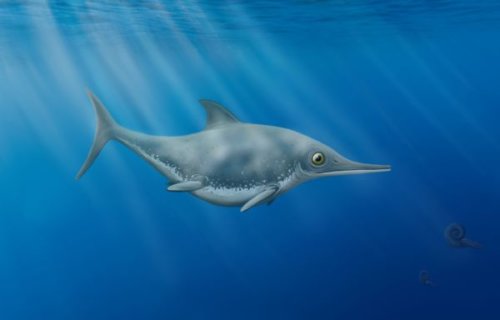PORTSMOUTH, United Kingdom — Dragons are usually reserved for fairy tales and works of medieval fiction like “Game of Thrones,” but a new discovery in the United Kingdom proves these mythical creatures had some real-life relatives in the sea. An amateur fossil hunter has uncovered a new type of prehistoric sea dragon on a beach located on U.K.’s Dorset coast.
Dr. Steve Etches discovered these groundbreaking fossilized remains buried head-first in limestone. This “Etches sea dragon” is an ichthyosaurus, measuring about six and a half feet in length. Ichthyosaurs in general are often referred to as sea dragons due to their particularly large teeth and eyes.
Upon finding the fossil, Dr. Etches immediately noticed that the teeth were unlike any other ichthyosaurs he had seen before. So, he passed along his discovery to researchers at the University of Portsmouth for an analysis.
This led to Megan Jacobs, a UP graduate student, identifying the fossil as a completely new genus and species that lived roughly 150 million years ago. Jacobs had been studying ichthyosaurs for several years prior, so she’s something of an expert on the topic.
More specifically, the fossil was discovered near Kimmeridge Bay in a limestone called the white stone band. Kimmeridge Bay is a designated area of the Jurassic Coast World Heritage Site.
Preserved for millions of years
Researchers say that when this sea dragon passed away, the seafloor was likely a very soft, malleable ooze. This allowed the dragon’s upper body to sink into the mud. The sea dragon’s exposed bottom half was presumably eaten by nearby scavengers in pursuit of a meal.
While all that doesn’t sound very pleasant for the sea dragon, it’s quite advantageous for modern scientists. Being stuck in limestone for hundreds of millions of years preserved the dragon’s front half remains. Some of its soft tissues are even intact.
“Skeletons of Late Jurassic ichthyosaurs in the UK are extremely rare, so, after doing some research, comparing it with those known from other Late Jurassic deposits around the world, and not being able to find a match was very exciting,” Jacobs says in a university release. “Thalassodraco etchesi is a beautifully preserved ichthyosaur, with soft tissue preservation making it all the more interesting.”
“Steve’s incredible collection contains many new and exciting animals, and being given the chance to describe this ichthyosaur was a real privilege,” she adds.
Sea dragons were born to catch elusive prey
In their day, ichthyosaurs were highly efficient aquatic predators. The shape of their body facilitated easy gliding. Their big eyes provided strong vision and their elongated jaws and sharp teeth made catching even slippery prey like squid or fish relatively easy.
Thalassodraco etchesi also boast a deep ribcage, hundreds of additional smaller teeth, and small forelimbs.
“Steve is an exceptional fossil collector and although he is sometimes referred to as an amateur collector, he has done so much for palaeontology that he has been awarded an MBE, and is truly a pro,” says Professor David Martill, who leads the vertebrate paleontology research at the University of Portsmouth. “If it were not for collectors like Steve, scientists would have very few specimens to work on.”
Moving forward, researchers aim to get to work on investigating the sea dragon’s unique biology.
“There are a number of things that make this animal special, not least of which is its unusual rib cage and small flippers. It may have swum with a distinctive style from other ichthyosaurs.” Prof. Martill adds.
Where is the sea dragon now?
Today, the fossil can be found on display in Dr. Etches’ own museum in Dorset.
“I’m very pleased that this ichthyosaur has been found to be new to science, and I’m very honored for it to be named after me,” Dr. Etches concludes. “It’s excellent that new species of ichthyosaurs are still being discovered, which shows just how diverse these incredible animals were in the Late Jurassic seas.”
If you’re hoping to catch a glimpse of one of these sea dragons on your next trip across the pond, unfortunately we’re all a bit too late for that. It’s estimated that the last ichthyosaurs went extinct around 90 million years ago.
The study is published in PLOS ONE.
